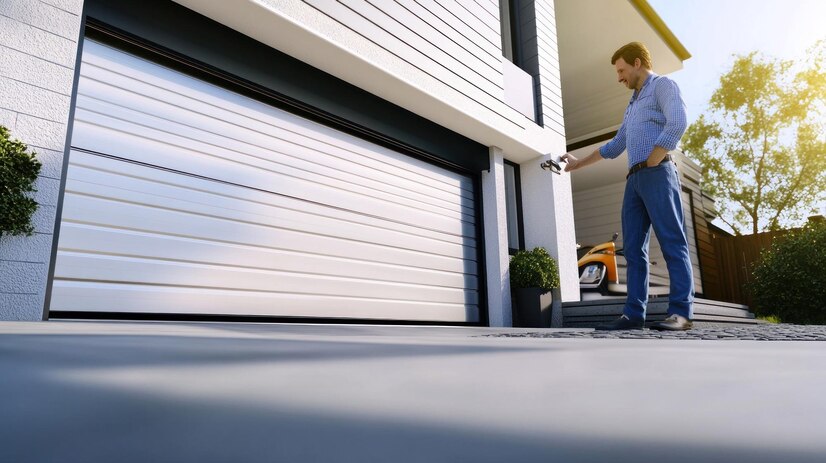A garage door that won’t open can be a frustrating and stressful situation, especially when you need to leave for work or return home. Understanding the common reasons why your garage door is stuck and knowing how to troubleshoot the issue can save you time and money. In this guide, we’ll walk you through possible causes, DIY solutions, and when to call a professional for help.
Common Reasons Your Garage Door Won’t Open
There are several reasons why your garage door may not be opening. Below are the most common causes:
1. Power Issues
- Check if the opener is plugged in properly.
- Inspect the circuit breaker to ensure it hasn't tripped.
- Test the remote control with new batteries.
2. Broken Garage Door Springs
- If you hear a loud bang or notice a gap in the torsion spring, it may have broken.
- Springs are under high tension and should be replaced by a professional.
3. Misaligned or Blocked Sensors
- Ensure the photo-eye sensors are clean and properly aligned.
- Remove any debris blocking the sensor’s path.
4. Track Misalignment
- Check for bends or gaps in the metal tracks.
- Use a rubber mallet to gently tap misaligned sections back into place.
5. Broken or Snapped Cables
- If cables appear frayed or snapped, they need immediate replacement.
- Do not attempt to repair cables on your own as they support heavy loads.
6. Manual Lock Engaged
- Some garage doors have a manual lock that may have been engaged by accident.
- Ensure the lock handle is in the open position.
7. Remote Control or Keypad Issues
- Reprogram the remote or replace the batteries.
- Reset the keypad if it isn’t responding.
8. Weather Conditions
- Extremely cold weather can cause parts to contract and jam.
- Lubricate the moving parts with a silicone-based garage door lubricant.
DIY Solutions for a Stuck Garage Door
If your garage door isn’t opening, try these troubleshooting steps before calling for professional help:
Step 1: Check the Power Source
Ensure that the opener is plugged in and that the outlet is functional. Reset the circuit breaker if necessary.
Step 2: Try the Manual Release Cord
Pull the emergency release cord (usually a red rope hanging from the opener) to disengage the motor and operate the door manually.
Step 3: Inspect the Tracks and Rollers
Clean the tracks and remove any dirt or debris. If you notice dents or bends, use a hammer and a wooden block to realign them gently.
Step 4: Lubricate Moving Parts
Apply a garage door lubricant to springs, rollers, and hinges to reduce friction and improve movement.
Step 5: Test the Sensors
Align the photo-eye sensors and wipe them with a clean cloth to remove any dust or dirt that may be blocking the infrared beam.
Step 6: Reset the Garage Door Opener
Unplug the opener for about 30 seconds and then plug it back in to reset the system.
When to Call a Professional
While some garage door issues can be fixed on your own, others require the expertise of a professional. Consider calling a technician if:
- The garage door spring is broken.
- The cables are snapped or frayed.
- The door is off-track.
- You suspect an issue with the opener’s motor.
- The door makes unusual noises or jerky movements.
Preventative Maintenance Tips
To prevent future issues with your garage door, follow these maintenance tips:
- Inspect and lubricate moving parts every few months.
- Test the balance of the door by disconnecting the opener and manually lifting it halfway.
- Check the sensors and tracks for alignment.
- Tighten loose bolts and screws to prevent vibrations.
Frequently Asked Questions (FAQs)
1. What should I do if my garage door opener is not responding?
Check the power source, replace the remote batteries, and try resetting the opener.
2. Can I replace a garage door spring myself?
No, garage door springs are under high tension and can cause injury. It’s best to call a professional.
3. How do I manually open my garage door during a power outage?
Pull the emergency release cord to disengage the opener and lift the door manually.
4. Why is my garage door making a loud noise?
Loud noises can indicate issues with the springs, rollers, or opener. Lubricate the parts or call a technician if the noise persists.
5. How often should I maintain my garage door?
Regular maintenance every six months will keep your garage door in optimal condition and prevent costly repairs.
6. Why does my garage door reverse before closing?
This issue is often caused by misaligned or dirty safety sensors. Clean and realign them to fix the problem.
7. What type of lubricant should I use on my garage door?
Use a silicone-based lubricant specifically designed for garage doors to avoid dirt buildup.
8. Can extreme weather affect my garage door?
Yes, cold temperatures can cause metal parts to contract, while heat can cause expansion. Regular maintenance can help mitigate these effects.
9. Why does my garage door only open halfway?
This could be due to a broken spring, an issue with the opener, or an obstruction in the tracks.
10. How much does it cost to repair a garage door?
The cost varies depending on the issue, but minor repairs can range from $100-$300, while major repairs may cost more.
Final Thoughts
A best garage door repair near me that won’t open can be inconvenient, but identifying the cause and taking proper action can help resolve the issue. By following basic troubleshooting steps and performing routine maintenance, you can ensure that your garage door remains functional for years to come. If the issue seems complex or involves critical components like springs or cables, it’s always best to seek professional assistance to ensure safety and proper repair.





Comments